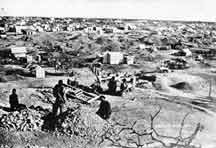Diamonds, The King of Gems, Page 2
By SYDNEY H. BALL, Ph.D.
When diamonds were said to have been found in South Africa, important London financial houses sent a leading engineer, Gregory, out to investigate. He rightly found conditions different from the Indian and Brazilian occurrences and therefore concluded that the diamonds were planted by real estate speculators who desired to sell their holdings. When a mining engineer errs, the public is without charity, and today, as you sip your "sun-downer" at the Kimberly Club, if you tell a tall story, you are "Gregorizing.
In 1870 the stolid Boer farmer, Dutoit, sitting idly before his cabin late one afternoon, saw a diamond sparkling in its adobe walls. Soon he spotted 16 more, and the South African pipes, the world's diamond EI Dorado, were a reality the instrument which made Cecil Rhodes and, through him, Rhodesia.

1871: THE EARLIEST DIGGINGS
There is an unimportant diamond field in Shan-Tung, China. The Chinese peasant and his habits are always interesting. Rains, he believes, produce diamonds, and after rains, the native, shod in straw sandals, walks over the fields. Naturally, the sharp-pointed diamonds stick in the sandals. These are then burned and the diamonds recovered from the ashes. (If there are any metallurgists present, 1 can assure you that the patent has expired on this process and you can use it as you see fit.)
Up to the discovering of the South African pipes-old volcanoes filled with a dark-colored igneous rock's-all diamonds had been recovered from stream gravels; that is, all mines were placers. Twenty-five years ago, however, the South African pipes were dominant in the industry. They since have lost their pride of place as to production to the alluvials farther north, but may regain it in 1949.
Most gem diamonds are small, but there is an exclusive club of producers of large stones. The old members were India, South Africa and the small Bagagem district in Brazil. Sierra Leone was admitted two or three years ago. The club's admission committee is considering the application of Venezuela and Tanganyika Territory.
Remember that diamond mining is 2,500 years old and that it employs some 125,000 men. The all-time production has been a little over 78 tons, the chief contributors being the Union of South Africa and the Belgian Congo. Without interstices, this would form a cube nine feet on a side, but cut gemstones of one carat or more of good quality would form a cube hut 2.5 feet on a side. Therefore, the woman who wears a one carat or larger solitaire is a stand-out, whether or not she belongs to the Daughters of the American Revolution, or the Colonial Dames. She owns an integral and an appreciable part of one of the world's most precious commodities.
Today, I estimate that the world's production ranges from 9,000,000 to 14,000,000 carats a year of which about 2,500,000 carats-say 1209 pounds-is of gem grade.
Broadly, mining and milling methods are similar to those of metal mining, except that the gravel or rock treated is very low grade. To get a unit of diamonds we mine from 20,000,000 to 60,000,000 rock units. The average hardworking diamond miner, with luck, may produce a grain a day. And Job was supposed to be patient!
Stones available for use as gems must, of course, be cut. To cut a diamond to give it its maximum brilliancy, the cutter must know not only the crystallographic characters of his piece of rough, but also optics. Before World War II, Belgium and Holland were the great cutting centers. In 1940 these were blacked out and the cutting industries, formerly unimportant, expanded in our own country, Porto Rico, and Brazil. They also sprang up in Palestine and Cuba. In the past year and a half the Belgian and Dutch industries have revived.
 Printer-friendly version
Printer-friendly version
